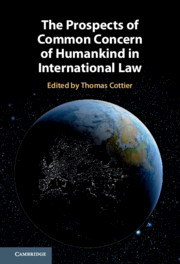Book contents
- The Prospects of Common Concern of Humankind in International Law
- The Prospects of Common Concern of Humankind in International Law
- Copyright page
- Contents
- Figures
- Contributors
- Preface
- Acknowledgements
- Abbreviations
- Part I Theory
- Part II Case Studies
- 2 Trade-Related Measures to Spread Low-Carbon Technologies
- 3 Marine Plastic Pollution as a Common Concern of Humankind
- 4 Exploring the Recognition of New Common Concerns of Humankind
- 5 Reshaping the Law of Economic Sanctions for Human Rights Enforcement
- 6 Migration as a Common Concern of Humankind
- 7 International Monetary Stability as a Common Concern of Humankind
- 8 Financial Stability as a Common Concern of Humankind
- Part III Epilogue
- Index
- References
2 - Trade-Related Measures to Spread Low-Carbon Technologies
A Common Concern–Based Approach
from Part II - Case Studies
Published online by Cambridge University Press: 04 May 2021
- The Prospects of Common Concern of Humankind in International Law
- The Prospects of Common Concern of Humankind in International Law
- Copyright page
- Contents
- Figures
- Contributors
- Preface
- Acknowledgements
- Abbreviations
- Part I Theory
- Part II Case Studies
- 2 Trade-Related Measures to Spread Low-Carbon Technologies
- 3 Marine Plastic Pollution as a Common Concern of Humankind
- 4 Exploring the Recognition of New Common Concerns of Humankind
- 5 Reshaping the Law of Economic Sanctions for Human Rights Enforcement
- 6 Migration as a Common Concern of Humankind
- 7 International Monetary Stability as a Common Concern of Humankind
- 8 Financial Stability as a Common Concern of Humankind
- Part III Epilogue
- Index
- References
Summary
Climate change is a well-recognized common concern of humankind. On that basis, this chapter explores the implications of the Common Concern doctrine upon climate motivated rulemaking and implementation in the trade regime. The particular aspect of the climate change problem dealt with here is that of low-carbon technology diffusion. It is proposed that based on this doctrine, the prevalent narrative of trade and technology diffusion issues be reframed in a way that prioritizes the need for resolving existing market failures preventing new technologies from being adopted, especially those of high price, absence of incentives and lack of financing options. Going further, the chapter then closely analyses two potential trade measures – (i) carbon pricing with cross-border recycling of revenue for technology support, and (ii) better rates of official export credit support for low-carbon technologies. It is found that the doctrine of Common Concern, apart from being an excellent normative framing device, can aid better understanding of the WTO rules, and also inspire reforms thereof to facilitate diffusion of clean technologies.
Keywords
- Type
- Chapter
- Information
- Publisher: Cambridge University PressPrint publication year: 2021
References
Select Bibliography
- 2
- Cited by



